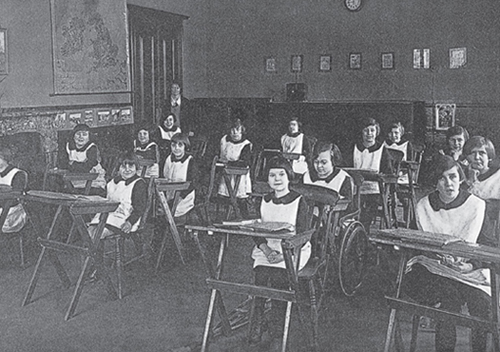Children with disabilities
A widely used approach in childcare, historically, was the ‘curative’ policy (Midwinter, 1994). This sought to treat those children and adults deemed deficient in some way in specially set up locations. These institutions were often forbidding places, offering a harsh ‘cure’ to those unfortunate enough to be admitted. This was the fate of many disabled children in the course of the twentieth century. Of particular relevance is Out of Sight: The Experience of Disability 1900–1950 (Humphries and Gordon, 1992), which portrays the lives of ‘ordinary’ people with disabilities in the UK through their own eyes and in their own words, from childhood to adulthood.
Mary Baker, for example, recalls how, in 1935 when she was 12 years old, she was sent to Halliwick Hall for Crippled Girls, a Church of England institution for girls with physical and mental disabilities. Mary’s particular disability was a dislocated hip, which meant that she walked with a limp. Until 1933 she had lived at home with her parents and three brothers. Their mother died that year, and the authorities decided that their father, who had been wounded in the First World War, would not be able to care for them. Consequently the children were sent to the workhouse at Wimborne Minster. From there Mary was separated from her brothers and sent to Halliwick Hall. This is her story.
Mary Baker
When I first arrived at Halliwick the nurse took me off to the bathroom and she stripped me off completely. She cut my hair short right above the ears. And then I was deloused with powder of some description. Then they put me in a bath and scrubbed me down with carbolic soap. It was very degrading to me. And I felt as though the end of the world had come and so I cried, I sat in the bath and cried my eyes out. At any rate they told me it was no good crying and dried me down. They used such rough towels it felt like they were sandpapering me. Then I was dressed in the Halliwick uniform, navy blue socks, stockings and a gym slip and a serge jumper, and I was taken into the dormitory, a big, huge room it seemed, with about ten beds in it. I went in there and lay down on my new bed. I felt awful and I thought that nobody cared for me. Anyway, I don’t think that I slept that night, I felt so lonely. I didn’t know what to do, had no idea what I was going to do. But it was huge and it was lonely, the place. And I felt really lost and I thought, what am I going to do with no one to love me?
I had entered a different life. My father was far back home and I thought that everyone had forsaken me. I think I cried most of the night. So this was my start. The next morning you were given a number and you had to remember it. My number was 29 and when I got up and went to wash, my towel and flannel had my number on them. Twenty-nine was engraved on all my hairbrushes and things with a big hot poker-like thing. Everything I owned had a marking of 29 on, so I can never forget that number. Our lockers in the playroom had the same number, and our clothes were marked with our numbers, so we knew what we had. We were hardly ever called by our first names, only by the other girls. And if Matron wanted you she called you by 29 or whatever number you had. We never had names, we were just numbers there. It was all very disciplined. I couldn’t make it out at first, why we should all have numbers and not names. I felt a bit low about it. I couldn’t really put my feelings into an expression, only that I felt very lonely about it.
(Quoted in Humphries and Gordon, 1992, pp. 68–70)
Mary’s story illustrates the worst features of loss of home and family and admission to an institution. Here we see the ‘clean break’ from home and the loss of everyone and everything that mattered. She remembers her sense of total devastation, how she felt ‘forsaken’ and that ‘nobody cared’ about her. Her initiation commenced at once with the stripping and cleansing process, with the removal of her clothes and cutting of her hair, and the compulsory bath. She was no longer a person with a name, she had become simply ‘number 29’.
This too is autobiography as history. We can see and feel, through Mary’s first-hand experiences, the childcare practices of the time. Through her story we can also gain some insight into earlier attitudes to poor families and to children with disabilities and catch a glimpse of the awful dehumanising effects of institutionalisation.
Find out more
You can learn more in our free course, Supporting children’s mental health and wellbeing [Tip: hold Ctrl and click a link to open it in a new tab. (Hide tip)] .

